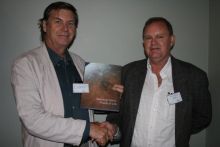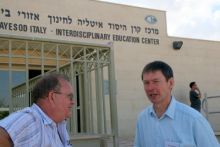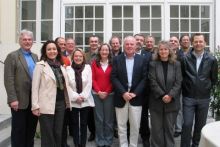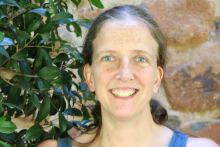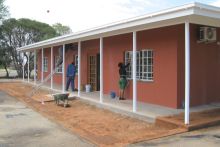SAEON gears up to tackle twenty eleven head on
|
As another year goes belly-up it is time to reflect on SAEON’s status, and the good news is that, overall, we are achieving the main objectives we’ve set for ourselves, plus some more.
Many colleagues and partner organisations have made this possible; in particular I would like to mention our core sponsor (the Department of Science and Technology), our lead agency (the National Research Foundation) and our host organisations (SANParks, SANBI, SAIAB, Oceans and Coasts, and Ezemvelo KZN Wildlife).
Many more colleagues and organisations functioned as members of the SAEON Advisory Board and Node Liaison Committees. Numerous partners, students, teachers, learners, co-sponsors and service providers have been responsive to our needs and have contributed to the achievement of our objectives.
Dr Wayne Twine of Wits Rural Facility deserves special mention for coordinating the SAEON Summit’s science programme.
SAEON's own staff members have been exemplary in their dedication and creativity when it comes to problem solving.
Achievements of some key objectives are briefly recorded here:
Objective 1: Complete the establishment of all planned SAEON nodes
The construction of the office blocks for the Arid Lands Node in Kimberley and the Grassland-Wetland-Forest Node in Pietermaritzburg has been completed and IT and telephone networks are currently being installed.
The Node Coordinators for the Arid Lands and the Grassland-Wetland-Forest Nodes will take up their positions in January 2011. The two nodes will also employ two field technicians each as of February 2011. More appointments will follow later in 2011.
Objective 2: Implement the SAEON Core Science Framework to increase projects and outputs
The SAEON Core Science Framework outlines the science plan that SAEON has to follow in order to meet its mandate. It was formulated through a consultative process, and was adopted as the guiding framework in 2009. Early in 2010, the document was published as a book (ISBN 978-0-620-46599-1).
The implementation of the Framework is the responsibility of individual nodes. To this end, each node has developed a node-specific science plan based on the Framework. The node-specific science plans have been tabled at the meetings of the Node Liaison Committees in the course of the year. A total of 68 projects are active on the projects’ database, and eight publications had been registered by the end of the second quarter of 2010/11.
Objective 3: Undertake the required development work for the implementation of the South African Earth Observation Strategy (SAEOS)
SAEON was contracted by the Department of Science and Technology (DST) to provide the platform for SAEOS and to maintain and support the platform until March 2012. It is clear that SAEON can make a substantial contribution to the initiative, both by providing data or leveraging existing agreements with, or links to data providers, and by contributing its existing infrastructure and clearinghouse platform as a basis for SAEOS. At the same time SAEON is interacting with GEOSS on the development of standards for the GEOSS interoperability.
The project commenced in September 2009, and had as one of its first goals to release a demonstrator portal for the GEO VI Plenary in Washington, D.C. in November, 2009. This milestone has been achieved. Refer to http://saeos.qsens.net.
The beta version of the South African Earth Observation System portal was demonstrated at the recent GEOSS Work Plan Symposium held in Pretoria in May 2010, to a positive reception.
Objective 4: Populate the CoGIS portal with data and make it fully operational
An operational data portal is available at http://data.saeon.ac.za. A large collection of meta-data, including 80 data sets created and maintained by SAEON, are available in the portal.
Substantial new functionality was developed for the portal. These include improved web-based mapping, charting and data presentation facilities; GEOSS-compliant search and query services; and faster harvesting, improved indexing, and quicker searches.
In related development, the shared data portal is now in use by beta versions of the South African Risk and Vulnerability Atlas, the SAEOS Portal, and the World Data Centre for Biodiversity and Human Health in Africa. SAEON has also completed, populated and is hosting the national portal for the Nairobi Clearinghouse mechanism.
Objective 5: Organise SAEON Summit on long-term environmental change research
The second SAEON Summit was held in October 2010 at the Kirstenbosch Conference Centre in Cape Town.
The theme of the Summit was “Successful observation of environmental change” and the programme was organised under the following sub-themes: Coastal and Marine Ecosystems; Freshwater Ecosystems; Terrestrial Ecosystems; Approaches and Methods; Environment and People; and Ecosystem Data.
The aim of the Summit was to provide a forum for sharing experiences of successful design and implementation of environmental change observation regimes in different bio-geographical regions in South Africa. Through both interactive platforms presentations and workshops, the Summit also aimed at engendering a better understanding of the requirements of, and methodologies for effective and efficient observation of environmental change. The Summit was similarly intended to place human beings at the centre of environmental change discourse by looking at the implications of such change on human activities and livelihoods.
The Summit was attended by 109 delegates over two days, including international delegates from Botswana, Mexico, Namibia, the United Kingdom, and the United States of America. In total 13 invited talks were delivered, two of them by international speakers.
At the end of the Summit, the SAEON Fynbos Node was officially launched by the Deputy Minister of Science and Technology. The day after the Summit was dedicated to SAEON Graduate Student Network (GSN) activities that culminated in the award of prizes to the authors of the three best student posters.
Objective 6: Coordinate IBSA Millennium Ecosystems Assessment project
SAEON was contracted by the DST to coordinate the initial phase of developing a trilateral follow-up millennium ecosystem assessment programme for South Africa, India and Brazil. It set up a team of experts in South Africa who worked on a proposal that was registered with the Millennium Ecosystem Assessment (MA) Secretariat in Japan. It also coordinated the establishment of similar teams in India and Brazil that prepared and submitted their country proposals to the MA. The last leg of the initial phase was the organisation of a trilateral sub-global assessment (SGA) workshop that was held in Pretoria in May 2010.
Objective 7: Expanding its international role
SAEON continues to actively expand its international role. This year we started hosting the GEO BON secretariat and we continued to function as the secretariat for the Southern African Data Centre for Oceanography (SADCO).
We contributed three chapters to the 2nd National Communication on Climate Change and are the national contact for the Belmont Forum’s theme of “Securing Biodiversity-ecosystem services baseline”. As mentioned, SAEON has also successfully organised a trilateral workshop between South Africa, Brazil and India on the development of a project under the Sub-Global Assessment of the Millennium Assessment.
SAEON staff members have furthermore been invited or elected to serve on a number of international committees. These include the International Council for Science’s ad hoc Strategic Committee on Scientific Information and Data (SCIDD) and a working group of its Scientific Committee on Oceanography, the International Long-Term Ecological Research (ILTER) Network’s Public Policy Committee and the organising committee of the Southern Hemisphere Meteorology and Oceanography Conference. SAEON also manages the data for the African Coelacanth Ecosystem Programme and is active in the Western-Indian Ocean Marine Science Association.
International visits were hosted, including visiting scientists from CSIRO/Tasmania, Mexico LTER and the Environmental Protection Agency of Shanghai Province, China. Experiences in education-outreach were exchanged with the National Oceanographic Centre of Southampton. Presentations were made to marine science conferences in Alaska and Japan.
Objective 8: Strengthening its education outreach function
The programme reinforced its hands-on science approach at all the nodes. The learners have reported enthusiastically about the impact of the science camps where they interact with scientists and learn about the scientific method of environmental monitoring.
The weather and climate education programme supported by Murray & Roberts provided weather stations, and weather-related activities were developed to support the curriculum.
The acquisition of the Magic Planet by Egagasini Node promises to be an exciting way of demonstrating and teaching about aspects of the Earth systems.
The SAEON Special Awards for Best Projects in Environmental Sciences were prominent at the 30th anniversary of the Eskom Expo for Young Scientists
The first SAEON Education Symposium hosted by the Ndlovu Node was a success. Teachers and learners from the four nodes shared their experiences of how they have benefited from the SAEON science education programme.
The DST/NRF internship programme has grown and the interns are appreciating the experience that prepares them for the job market.
SAEON publications for 2010/11
Billaney, W., Swart, S., Hermes, J. C., and Reason, C., (2010) Variability of the southern Ocean fronts of the Greenwich Meridian. Journal of Marine Systems, 82(4): 304 – 310
O’Connor, T. G., Kuyler, P., Kirkman, K. P. and Corcoran, B., (2010) Which grazing management practices are most appropriate for maintaining biodiversity in South African grasslands? African Journal of Range & Forage Science, 27(2): 67 – 76
O’Connor, T. G., De Ridder, C. H., and Hobson, F. O. (2010) Aspects of the seed ecology of Acacia karroo in the Eastern Cape, South Africa. African Journal of Range & Forage Science, 27(2): 76 – 87
O’Connor, T. G., (2010) Transformation of riparian forest to woodland in Mapungubwe National Park, South Africa, between 1990 and 2007. Austral Ecology 35, 778–786
Saidi, A. and Pauw, J., (2010) Regions and the environment: experiences of environmental research networks in southern Africa. South African Geographical Journal, 92(1): 63 – 80.
Saidi, T. A. and Malivhoho, M. C., (2010) System inertia in the changing paradigm for biodiversity conservation in South Africa. Africa Insight, 39(4): 99 – 108.
Saidi, T. A., (2010) Environmental impact assessment as a policy tool for integrating environmental concerns in development. Africa Institute of South Africa Policy Brief 19.
Thompson, D., Anderson, N., and van Staden, J., (2010) Colchicine-induced somatic polyploids from in vitro-germinated seeds of South African Watsonia species. Hortscience 45(9): 1- 5.
Palmer, B.J., McGregor, G.K., Hill, T.R. and Paterson, A,W, 2010: A spatial assessment of coastal development and land use change in the Eastern Cape, South Africa, South African Geographical Journal, 92, 117 – 128


